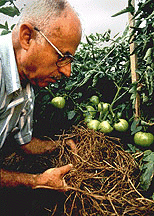| Home
|
| Sustainable Farming Connection |
| Where farmers find and share information. |
Test Plot Results
No-till transplanting yields more tomatoes, fewer pests and $550/A savings.
Groff tested four different methods of killing covers before transplanting tomatoes into demonstration plots on a 1.5-acre field in 1995. Three treatments involved hairy vetch that had been no-till drilled the previous August at 20 lb./A. Sampling in May showed the vetch provided a total of 170 pounds of N per acre.
The four treatments were:
- Spraying vetch with one-third pound of Sencor and 1 pint of Gramoxone per acre, plus rolling it once the next day with just the depth-control roller on a flail mower.
- Flail mowing vetch.
- Killing vetch by spring plowing and two diskings .
- No vetch. (Fall-plowed and disked three times. Received 5 tons of steer manure -- about 60 lb. N/A.)
 Aref Abdul-Baki inspects vetch mulch. [USDA-ARS Photo] |
Controlling perennial weeds can be a challenge in no-till. But Groff has found that with intensive crop rotation and occasional spot spraying, weeds can be managed effectively.
The no-till demo plots gave the best yields. The first four pickings of tomatoes yielded a total of 73 baskets for each of the no-till treatments, vs. 70 in the fall-plowed treatment. The spring-plowed treatment yielded 56 baskets. Although the demonstration didn't involve replicated plots, Groff says his findings are consistent with other research done by Tom Jurchak in Lackawanna County, and by Aref Abdul-Baki of the USDA Agricultural Research Service in Beltsville, Md.
Besides better yields and readily manageable weed levels, Groff saw less severe early blight defoliation in the no-till plots. "Colorado potato beetles were virtually absent in the no-till plots, but more apparent in the plowed ones. Researchers think the beetles prefer bare soil rather than soil covered with a mulch," says Groff, who noticed early on in the no-till plots some flea beetle pressure that didn't warrant any spraying.
His total savings when no-till transplanting tomatoes amounts to nearly $550 per acre, Groff estimates. Nearly $500 of the cost reduction is from material, labor and time savings when eliminating use of a plastic mulch. Bear in mind that a plastic mulch would still be needed for early-season tomatoes. In wet years, you might notice more slugs, but Groff says they haven't chewed his fresh-market tomatoes unless the crop is in contact with the soil.
"Erosion control is another area where no-till really shines," he says. "With the ground covered by plant residues and not loosened by vigorous tillage, the soil stays rather than getting washed away during heavy rainfall. With an average soil loss in Lancaster County of 9 tons per acre per year on the typical farm, you begin to realize the importance of keeping this valuable soil resource in place."
Groff also likes no-tilling pumpkins, sweet corn and peppers, as well as fall broccoli. "Pumpkins, in particular, are a lot cleaner, because the soil doesn't splash up on them when it rains." He figures the no-till method also would work for eggplant, melons and even snap beans. All of Cedar Meadow Farm's vegetable acreage is no-till now, except one-fourth acre of early tomatoes.
Groff's recent test-plot work has been supported by the USDA Sustainable Agricuture Research and Education Program (SARE), the Pennsylvania Association for Sustainable Agriculture (PASA), and Regional Infrastructure for Sustaining Agriculture (RISA).
 |
Groff's Guide To No-Till Transplanting |
  Video Video Smart Cover Cropping Smart Cover Cropping
 Transplanter
and Stalk-Chopper Modifications Transplanter
and Stalk-Chopper Modifications Test Plot Results Test Plot Results '97 Journal
Follow Steve's management strategies through the season. '97 Journal
Follow Steve's management strategies through the season.
|
| Top of Page |
| Home
|
©1998 Committee for Sustainable Farm Publishing
Please read about our usage permission policy and disclaimer.
Send comments, suggestions and questions to the site author:
Craig Cramer cdcramer@clarityconnect.com
Coded using HoTMetaL Pro 3.0. Best viewed in Netscape 3.0 or later.
Please see our credits page for more information.
http://sunsite.unc.edu/farming-connection/covercro/groff/testplot.htm